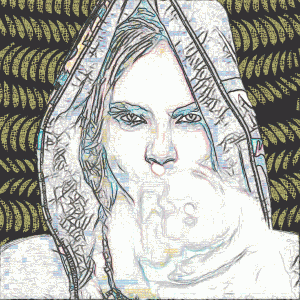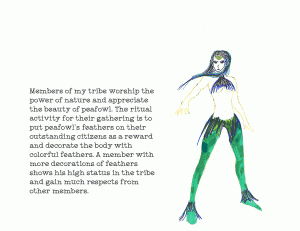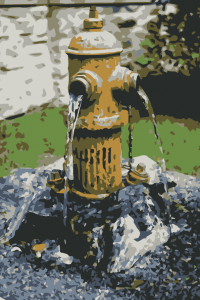Vis Comm: Gif and Animation Video Experiment
For the final GIF, I made two groups of contents that the background is designed to be the moving graphic patterns in green to show my tribe’s identity. And the front layers of a girl moving to give intensity of the GIF. I used photoshop to digitally trace my video and added filters on the layers. For the background, I drew in Illustrator and adjusted positions to create a moving forest.
During the process of making my final GIF, I had experimented some other gifs and exported them out as the source of my animation video. My primer sources of the gif are illustrated still pictures that were mostly done in Photoshop and Illustrator. By using the Timeline of Animated Frames, I created gifs and export them out to both gifs and rendered videos. Then I dragged my short clips into Premiere to edit my animation.
Editing key frames are crucial to my experiment animation. At the beginning of the process, while I was drawing the storyboard, I didn’t think of all the layers and interactions of each track and the clipping points of variety in motions would create unexpected effects of the animation. At the end of my video, I gave out a conceptual ritual activity of my peafowl tribe.
Vis Comm: Analog to Digital Presentation
Intro to Fashion Studies: What is Fashion?
When I thought of Fashion, I thought of Prada’s campaign that were printed in the magazine and getting switched seasonally; I thought of street style pictures that I saw online with celebrities wearing their stylish clothes and Hermes Birkin, holding a cup of coffee and proudly waling on the street; I thought of myself dressing up in the latest trend and going out with my girlfriends and getting drunk in the city lights. There were lot of images flashing into my mind when I thought about the word “Fashion”, concluded as the concept of “visual and material interpretations”. (Kaiser 2012: 1)
Earlier in this week, a neighbor who shared an elevator with me asked me about the Canada Goose coat that I was wearing. He asked me “I’ve heard about this coat, and what do you think of it?”
“Well, you know, it’s a nice coat, and a nice brand. Actually, I’m just trying to fit in as well as to stand out in my school. Because everyone there has nice coats, you know, expensive coats, and I thought winter is coming, so I got this. And frankly I was enjoying when my classmate gave compliments on my coat. But you know, it’s just a coat. I don’t think it worth $1000. $500 could be more reasonable.”
“Umm, I was just wondering that does it really keep you warm as it said?”
“Ahh, yes, it does. Sorry I misunderstood.”
I felt so awkward when I realized I literally quoted a sentence from Kaiser’s book to answer my neighbor’s casual question on my coat. But at that moment, I realized that I did have more perceptions on fashion and my “fashionable behaviors”.
Take this coat case as an example of what I think of fashion. I realize that the reason I buy this coat is very complicated. Because I do only buy an object and its warmth, I buy, according to Susan Kaiser (2012) mentioned in her book about Robert Williams theory, people also buy social respect, discrimination, health, beauty, success, power to control your environment. (Williams 1980: 47). And this buying behavior is absolutely the consumption part in fashion industry. But as we were told not to use binary thinking to analyze fashion, we can see that this behavior is also entangled with psychological and cultural influence of the brand as well as my subject formation- “who I am and who I am becoming” (Kaiser 2012: 21). It can be related to the habitus (Bourdieu 1984), and it also can be the historical, cultural, and economical influences. And now, when I think of fashion, images, and theories come to my mind like an overwhelming flood.
Sustainable System: Me and Anthropocene
Many scientists insist that recent human activity, beginning about 250 years ago, is having such a significant environmental impact on the Earth’s climate, geography, and biological composition that we have actually entered into a new period of geologic time — the “Anthropocene”. It means that human activities have shaped the geological shapes with the rise use of fossil fuels, industrialization of agriculture and inevitably, the urbanization.
Started from industrial revolution, we made ourselves aware of the improvement in transportation, medical research, artificial fertilization, markets, tourism, globalization, health, wealth, security and longevity. But with all the progress we have made, we are polluting the environment in many ways.
From the rise of the first urban settlements until the emergence of mega cities in the 20th century, the scale and intensity of urban pollution has increased. As where we have lived and we have been exposed, about 300 million tons of plastic is produced globally each year. We use it, and we dispose it. Because plastic is inexpensive, lightweight and durable, virtually every industry (retailing, manufacturing or logistics) loves it. However only about 10 percent of that is recycled.
To me, cities can be regarded as artificial environments created for the benefit of humans, and yet none of this liberates people from nature. Cities have to be fed and provided with energy and water in order to exist and sustain its human population. The bigger the city, the more resources and energy must be extracted from the surrounding areas to sustain it. But what we have done is that of the plastic that is simply trashed, an estimated seven million tons ends up in the sea each year. Others has become pollutions in soil, and landfills. Plastic accumulated over half a century is now out there.
Plastic pollution is a major global phenomenon that has crept up on us over the decades, and it really requires a global and comprehensive solution that includes systemic rethinks about usage and production. My final project for sustainable system, the urban plastic sculpture is hoping to raise awareness of the problem and the potential savings that can be made. Like transferring perishable plastic trash into art, or decorative use, and to prompt organizations to change the consumption patterns.
Adopting the Anthropocene name, the concept, and my initial approach to this project, both want to raise the awareness of the fact that humans are having enduring effect on the plant, and find ways to solve what we did wrong.
Me and Anthropocene Process
I recycled plastic bags for my project to make a city landscape sculpture to illustrate the anthropocene. Before heat fuse the plastic bags, I cut off the handles and saved them for further use.
Each building is made of an individual plastic bag. The heat of flat iron fused the layers together to make the plastic stick stronger and thicker.
By putting the fused plastic building on the recycled foam board, I started to structure the plastic city landscape. And for the cut of plastic bag handles, I tied them together to reduce wastes, and knitted them together and see what I can do with the outcome.
Vis Comm: Muybridge Gifs
Intro to Fashion Studies: Reflection on the Dressing Practice Log
Check our my dressing practice log here: tianlan-dressing-log
Besides the 7 photos that I had provided in my Dressing Practice Log. There are another 2 photos from my closet where I dress myself everyday.
To conclude what I had chosen to wear for the past week, I noticed that I chose a lot of grey and navy garments for my mundane life. I like grey and navy as I have told in my intersectionality maps about my aesthetic subject position. And I have bought tons of grey or navy clothes since they are easy to match and are always the safe choices for most occasions. In other way to say, most of clothes in my closet are navy or grey, so I can only choose from them. It’s like what Susan Kaiser mentioned in her article that most of the time, people create their own “fashion statement” but are ultimately constrained by what is available in the marketplace (Kaiser, 2012: 31), to me, it’s that is available in my wardrobe.
But I was not defined by the color of navy or grey. I admit that, sometimes, they are boring and conservative colors, and when I wore them on the Wall street and compared myself with others, I felt uncomfortable of being underdressed by only just wearing basic sweaters and pants among all these perfect fit suites and sharp cut dresses. Our consciousness of dress is heightened when something is out of place when either our clothes do not fit, or they do not match the situation, for example, when we find ourselves dressed too casually at a formal situation or too formally at a casual situation (Enteistle, 2002: 133-134). So I mixed myself with red cute dress on weekends to liberate the spirit. Also, it can be explained as I was dressing up for the occasions. For instance, if I was going out with friends or go clubbing. I dressed for social purpose. It is as Enteistle had said that our dress does not belong to our bodies but to the social world as well. So all the factors entangled together to act my dressing behavior since self-other relations also emerge as entangled, rather than binary.
However, it’s inevitable to find that my whole week dressing documentations are lack of colors, since most of the time, I picked random things in my closet that were available for me since I was running out of time for school. Like Woodward concluded in her publications, that when women are dressing in a hurry, one of the most important factors in deciding what she wear is ease of access (Woodward, 2007: 44) which for me, the clothes in navy or grey.
Bibliography
Enteistle, Joanne, 2002, “The Dressed Body”, Real Bodies: a Sociological Introduction, New York: Palgrave.
Kaiser, Susan.B., 2012, “Intersectional, Transnational Fashion Subjects”, Fashion and Cultural Studies, New York: Bloomsbury.
Woodward, Sophie, 2007, “Hanging Out in the Home and the Bedroom”, Why Women Wear What They Wear, New York: Berg.
Sustainable System: Non Human Project
Check the Full Version of my Presentation: non-human-project
Design for non human is a process of thinking out of the box. Having designed and used humanly oriented products, we enjoyed our convenience. But have we actually think of the animals and plants that share the same planet with us?
So I designed the hydrant system that can be inserted in the park to both decorate and provide supplies. (see file 2) The hydrant is connected to underground water pipes to provide clean and cool water source. Streams of running water keep going out of the hydrant for animals in the park to drink, and snacks part are set to give 1 cookie out every 5 minute. Stones pile around the hydrant to keep the ground clean without muds or dirt. And in summer, dogs can lie on the stone is they get too hot. Also, gaps between stone allow water to come back to the earth. A solar panel can be added on the top of the hydrant to collect sun energy which is used to the sensor of the hydrant. The sensor can be activated with any object within 2 meters around the hydrant. And in this case, where there is no dog or animals around the hydrant, it can also save water and save dog cookies as well. The set of functionality remains the same as it was set if there are lot of dogs around the hydrant to prevent the overeating habits of puppies.
–
We seldom think in a non human perspective. When we do, we feel the huge difference of objectives, we feel guilty of not bringing convenience to our buddy, our neighbor who also live on this planet, and we start to care more ever after we stay with them.
Also, fun fact about birds in WSQ Park, hope you will like it:
- Birds fighting for rice
- Larry
- Okay, he won
Intro to Fashion Studies: Campaign and Gender – Dolce & Gabbana A/W 2015
Though Vanessa Friedman concluded Jaden Smith wearing women’s wear for Louis Vuitton saying that we are entering the age of wear what you like, clothing norms and traditions have held on to the mass consumers. In the A/W 2015 campaign, Dolce & Gabbana paid tribute to mothers with its signature theme. The ads feature not one or two, but several generations of couture-wearing models – from Grandparents to the newest born babies, entirely dedicated to celebrating motherhood and the love of family by depicting natural scenes at a family gathering. As Susan Kaiser concluded in her book, clothes are public signals about how to read individuals, the A/W 2015 Dolce & Gabbana displayed full skirts and cinched waists with abundant of lace and florals to emphasize the ultra- feminine shapes. And on the textile design, many garments were emblazoned with words in French or Italian “I love you, Mom!” or had children drawings printed on.
However, fashion ads never escapes the criticisms from feminists that advertisement dehumanizes and demeans women- turning them into sexualized objects and proffering unattainable images of beauty that most often, young, white, thin women’s bodies are represented and consumed in hegemonic cultural disclosure. And unfortunately, this campaign partially fits into the definition that were mentioned in Kaiser’s book. For what it worth appreciating, this campaign paid endorsement of women, stated the indispensable position of women in the family and the fashion, truly beautiful with detailed gender coded symbols but not sexually seductive or cheap.
Maybe critics may considers this a little traditional, the campaign is undeniably fun and cheerful. Surely most consumers would notice first and found their engagement to this modern family portrait full of love and unity.
Sustainable System: Trash Transformer
Material: Used Duvet Cover- Teared into strips
Process: Weaving
Result and Function:































































